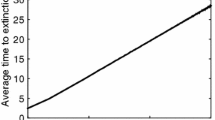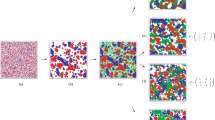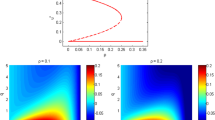Abstract
The recent paper of Sinha and Parthasarathy investigated the effect of modifying the Ricker and logistic population models to simulate the effects of immigration to, and emigration from, the population. Immigration of a fixed number of individuals was shown to reduce the probability of observing chaos in the Ricker model but not the logistic one. Here, isocline analysis is used to investigate why these effects occur. The stabilization effect for the Ricker equation occurs over a wide range of values of the immigration parameter. There are no values of the parameter, however, which increase the stability of the logistic equation substantially. In contrast density-dependent immigration is found to destabilize both the Ricker and logistic models. Density-dependent emigration serves to reduce the propensity of both models to exhibit chaos.
Similar content being viewed by others
References
Bascompte J and Sole R V 1994 Spatially induced bifurcations in single-species population dynamics;J. Anim. Ecol. 63 256–264
Berryman A A and Millstein J A 1989 Are ecological systems chaotic—and if not, why not?;Trends Ecol. Evol. 4 26–28
Bolker B M and Grenfell B T 1993 Chaos and biological complexity in measles dynamics;Proc. R. Soc. London. B251 75–81
Cavalieri L F and Kocak H 1994 Chaos in Biological Control Systems;J. Theor. Biol. 169 179–187
Ellner S and Turchin P 1995 Chaos in a noisy world: new methods and evidence from time series analysis;Am. Nat. 145 343–375
Godfray H C J and Grenfell B T 1993 The continuing quest for chaos;Trends. Ecol. Evol. 8 43–44
Gonzalez-Andujar J L and Perry J N 1993a The effects of dispersal between chaotic and non-chaotic populations within a metapopulation;Oikos 66 555–557
Gonzalez-Andujar J L and Perry J N 1993b Chaos, metapopulations and dispersal;Ecol. Model 65 255–263
Grenfell B T 1992 Chance and Chaos in Measles Dynamics;J. R. Stat. Soc. B54 383–398
Hastings A 1993 Complex interactions between dispersal and dynamics: lessons from coupled logistic equations;Ecology 74 1362–1372
Hastings A, Horn C L, Ellner S, Turchin P and Godfray H C J 1993 Chaos in ecology: Is mother nature a strange attractor?;Annu. Rev. Ecol. Syst. 24 1–33
Markus M 1992 Are one-dimensional maps of any use in ecology?;Ecol. Model 63 243–259
May R M 1974 Biological populations with non-overlapping generations: stable points, stable cycles and chaos;Science 186 645–647
May R M 1975 Biological populations obeying difference equations: stable points, stable cycles and chaos;J. Theor. Biol. 51 511–524
May R M 1976 Simple mathematical models with very complicated dynamics;Nature (London) 261 459–67
May R M and Oster G F 1976 Bifurcations and dynamic complexity in simple ecological models;Am. Nat. 110 573–599
McCallum H I 1992 Effects of immigration on chaotic population dynamics;J. Theor. Biol. 154 277–284
McCann K and Yodzis P 1994 Biological conditions for chaos in a three-species food chain;Ecology 75 561–564
Morris W F 1990 Problems in detecting chaotic behaviour in natural populations by fitting discrete models:Ecology 7 1849–1862
Rand D A and Wilson H B 1991 Chaotic stochasticity: a ubiquitous source of unpredictability in epidemics;Proc. R. Soc. London B246 179–184
Rohani P and Miramontes O 1995 Immigration and the Persistence of chaos in population models;J. Theor. Biol (in press)
Ruxton G D 1993 Linked populations can still be chaotic;Oikos 68 347–348
Ruxton G D 1994 Low levels of immigration between chaotic populations can reduce system extinctions by inducing asynchronous regular cycles;Proc. R. Soc. London B256 189–193
Sinha S and Parthasarathy S 1994 Behaviour of simple population models under ecological processes;J. Biosci. 19 247–254
Stone L 1993 Period-doubling reversals and chaos in simple ecological model;Nature (London) 365 617–620
Author information
Authors and Affiliations
Rights and permissions
About this article
Cite this article
Ruxton, G.D. The effect of emigration and immigration on the dynamics of a discrete-generation population. J Biosci 20, 397–407 (1995). https://doi.org/10.1007/BF02703843
Received:
Revised:
Issue Date:
DOI: https://doi.org/10.1007/BF02703843




